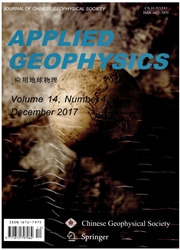

 中文摘要:
中文摘要:
常规声波测井解释方法建立在各向同性地层中的垂直井基础之上,对各向异性地层中的水平井和斜度井并不适用。在水平井和斜度井的钻井过程中,岩屑会溅到井壁并最终在井壁底部形成一层薄岩屑层。同时,高速层和各向异性也可能会影响声波时差的测量。本文采用结合了Hybrid-PML的交错网格时域有限差分方法(SGS-FDTD),研究阵列声波仪器在各向异性介质中的水平井和斜度井条件下,不同因素对测得时差所带来的影响。模拟结果揭示了声波时差在高速层,薄岩屑层,井斜角,层厚,各向异性等不同影响因素下的相应规律。我们发现当波长远小于井壁与高速层的距离时,能够准确测得目的层时差;然而在两者处于同一量级时的近场条件下,几何声学理论不再适用;当井眼底部存在岩屑层时,费马原理依旧适用,对真实时差测量没有影响;在各向异性地层环境下,井斜角的增大使得测得时差由垂直向时差逐渐趋近于水平向时差;对于特定源距的声系,仪器在目的层中所移动的距离超过一定距离时,方可获得薄层时差值。基于不同井斜角和不同各向异性大小均匀TI地层模型的模拟结果,绘制了时差估计图版,可以对任意井斜角和各向异性比的模型进行时差的定量估计。通过对不同声系和不同弹性参数的模拟实验,证明了这种时差估计方法对TI地层中的水平井和斜度井准确有效。
 英文摘要:
英文摘要:
The conventional acoustic logging interpretation method, which is based on vertical wells that penetrate isotropic formations, is not suitable for horizontal and deviated wells penetrating anisotropic formations. This unsuitability is because during horizontal and deviated well drilling, cuttings will splash on the well wall or fall into the borehole bottom and form a thin bed of cuttings. In addition, the high velocity layers at different depths and intrinsic anisotropy may affect acoustic logging measurements. In this study, we examine how these factors affect the acoustic wave slowness measured in horizontal and deviated wells that are surrounded by an anisotropic medium using numerical simulation. We use the staggered-grid finite difference method in time domain (FDTD) combined with hybrid-PML. First, we acquire the acoustic slowness using a simulated array logging system, and then, we analyze how various factors affect acoustic slowness measurements and the differences between the effects of these factors. The factors considered are high-velocity layers, thin beds of cuttings, dipping angle, formation thickness, and anisotropy. The simulation results show that these factors affect acoustic wave slowness measurements differently. We observe that when the wavelength is much smaller than the distance between the borehole wall and high velocity layer, the true slowness of the formation could be acquired. When the wavelengths are of the same order (i.e., in the near-field scenarios), the geometrical acoustics theory is no longer applicable. Furthermore, when a thin bed of cuttings exists at the bottom of the borehole, Fermat's principle is still applicable, and true slowness can be acquired. In anisotropic formations, the measured slowness changes with increments in the dipping angle. Finally, for a measurement system with specific spacing, the slowness of a thin target layer can be acquired when the distance covered by the logging tool is sufficiently long. Based on systematical simulations with differ
 同期刊论文项目
同期刊论文项目
 同项目期刊论文
同项目期刊论文
 期刊信息
期刊信息
